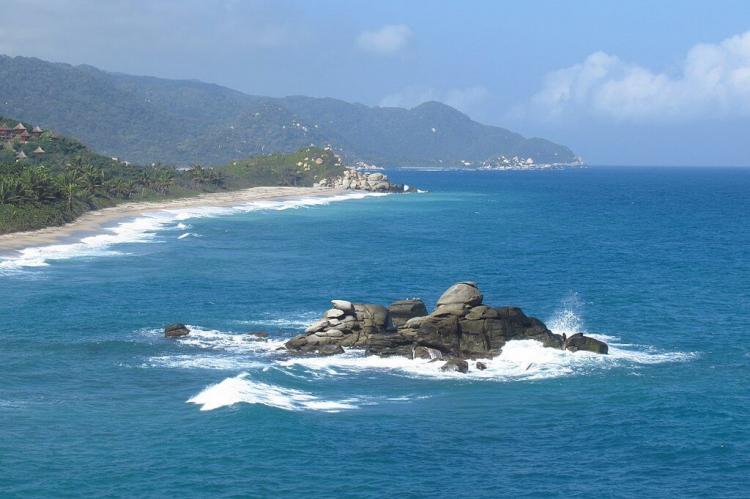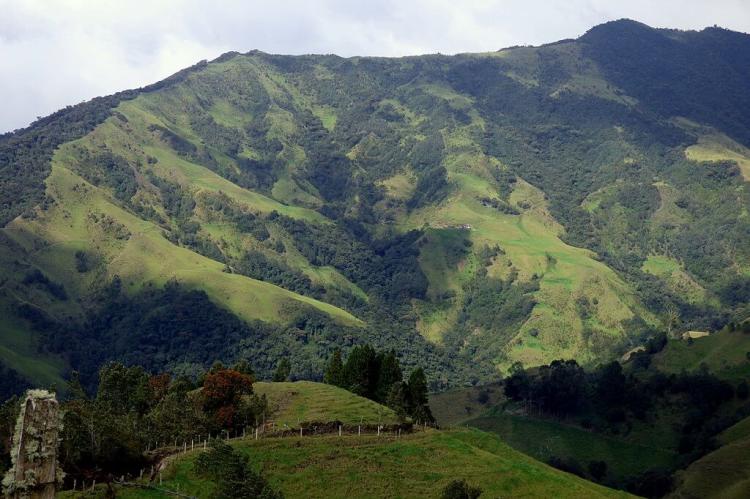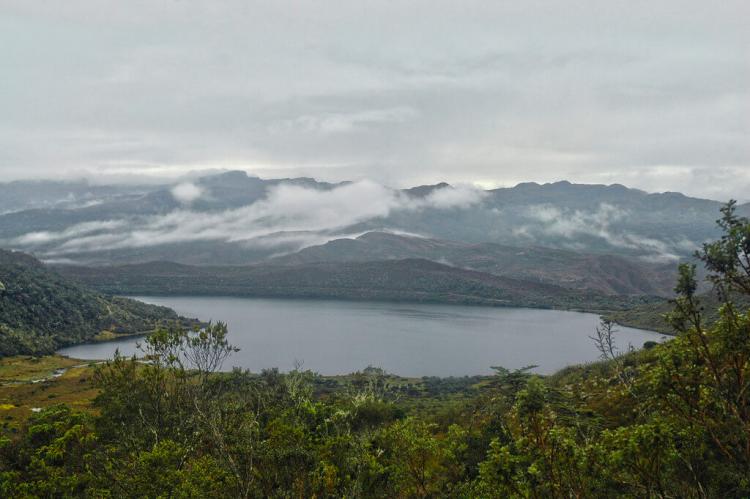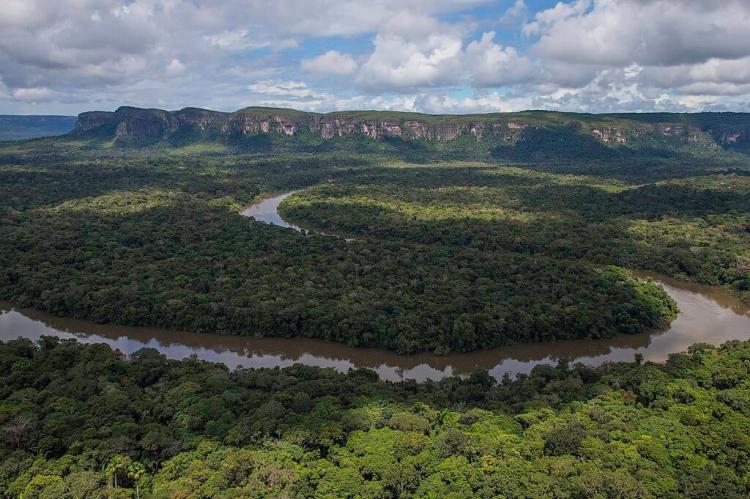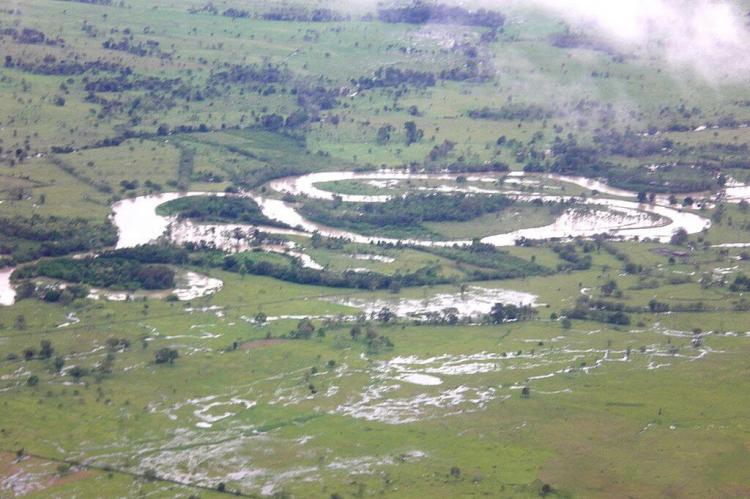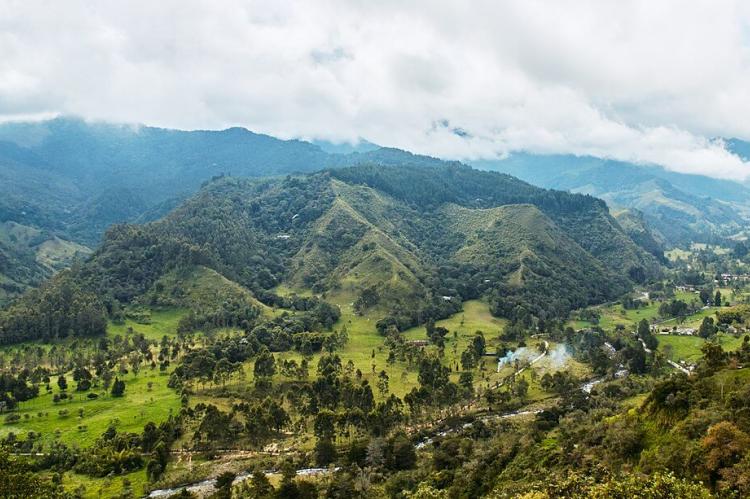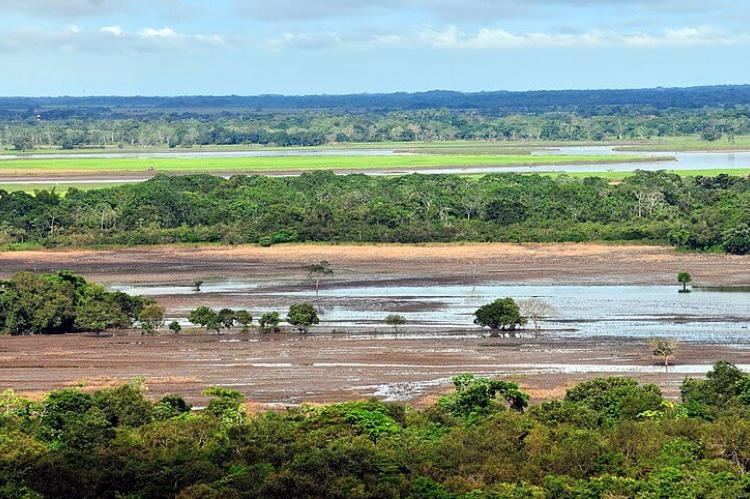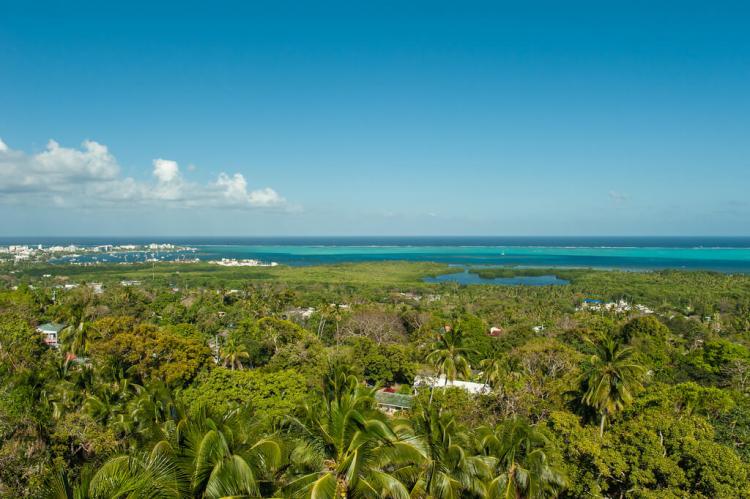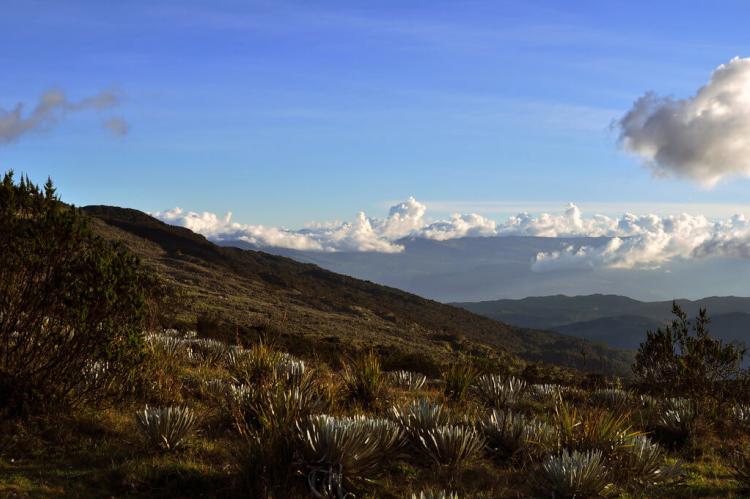Colombia: Natural Landscape
Colombia is considered a land of extremes. Located in northwestern South America, its geographic landscape varies from the snow-covered Andes mountains to the tropical beaches of the Caribbean Sea. Due to its variety of ecosystems, Colombia is among the top countries in terms of biodiversity.
The Natural Landscape of Colombia
Nestled in northwestern South America, Colombia shares its borders with Panama to the northwest, Venezuela and Brazil to the east, and Ecuador and Peru to the south. As the fourth-largest country in South America, Colombia spans a vast expanse that encapsulates a diverse array of landscapes and climates.
Colombia unfolds as a land of geographical extremes, offering a striking panorama that spans from the snow-draped peaks of the Andes Mountains to the sun-kissed tropical beaches along the Caribbean Sea. This breadth of topographical diversity contributes to Colombia's status as a country marked by an extraordinary range of ecosystems and climates.
Venturing into the heart of Colombia's natural beauty unveils the lush tropical forests of the Amazon and Pacific/Chocó regions, the pristine mountain páramos of the Andes, and the expansive grasslands of the Llanos. Each ecological realm harbors a unique flora and fauna, attesting to the country's unparalleled biodiversity.
Colombia's commitment to preserving this rich natural heritage is evident in its varied conservation efforts and initiatives. Colombia stands as a testament to the coexistence of diverse ecosystems within its borders, from the Andes' high-altitude wonders to the Amazon's untamed expanses.
Biodiversity
Colombia stands proudly as one of the planet's most biodiverse nations, earning its esteemed place among its megadiverse countries due to its abundant ecological and geographical variety. The country's landscapes range from lush tropical rainforests and towering mountain ranges to expansive coastal regions and intricate river systems, all contributing to the extraordinary wealth of biodiversity.
Distinguished by its myriad ecosystems, Colombia claims a spot within the top three countries globally in terms of biodiversity. As highlighted by the Global Biodiversity Index, Colombia's natural splendor is evident in its staggering array of species: 1,863 bird species, 812 amphibian species, 2,105 fish species, 477 mammal species, 634 reptile species, and an impressive 24,025 plant species. This wealth of life firmly places Colombia among the prestigious group of 17 megadiverse countries on Earth.
Conservation
Colombia's commitment to conservation is a vital and continuous endeavor driven by the imperative to protect its exceptional biodiversity, unique ecosystems, and invaluable natural resources. Renowned for its ecological diversity, encompassing tropical rainforests, towering mountain ranges, coastal expanses, and intricate river systems, Colombia's ecosystems serve as habitats for numerous species found nowhere else on Earth.
Colombia faces multifaceted challenges in conservation, including illegal armed groups, land conflicts, illicit crop cultivation, and the socio-economic pressures fueling deforestation and land degradation. Despite these formidable obstacles, Colombia remains resolute in preserving its distinctive natural heritage. The country actively engages in significant efforts to conserve its biodiversity, employing strategies that harmonize with sustainable development principles, ensuring a balanced coexistence of nature and human progress.
Climate
Colombia's climate is tropical along the coast and the eastern lowlands and cooler in the highlands and Andes. However, the country's proximity to the equator minimizes temperature variations throughout the year.
Colombia generally experiences warm, humid weather year-round. The mean annual temperature is 24 °C (75 °F), and the average humidity is 70%. However, the climate in Colombia varies greatly depending on the region due to the country's diverse topography.
Colombia can be divided into five main climate zones:
- Tierra Caliente (hot zone): This zone is located at sea level and up to 1,000 m (3,280 ft) above sea level. It is characterized by hot, humid weather with temperatures ranging from 24 - 32 °C (75 - 90 °F).
- Tierra Templada (temperate zone): This zone is located 1,000 - 2,000 m (3,280 - 6,560 ft) above sea level. It is characterized by mild, pleasant weather with temperatures ranging from 18 - 24 °C (64 - 75 °F).
- Tierra Fría (cold zone): This zone is 2,000 - 3,000 m (6,560 - 9,840 ft) above sea level. It is characterized by cool weather with temperatures ranging from 13 - 18 °C (55 - 64 °F).
- Tierra Helada (frozen zone): This zone is above 3,000 m (9,840 ft) above sea level. It is characterized by cold weather below 13 °C (55 °F).
- Páramos: Páramos are high-altitude grasslands above 3,500 m (11,480 ft) above sea level. Cold weather, strong winds, and high humidity characterize them.
Colombia also has two main seasons: the wet season and the dry season. The wet season runs from April to May and October to November, and the dry season runs from December to January and July to August. However, the timing and duration of the wet and dry seasons vary depending on the region.
Volcanism
Colombia is in the formidable Pacific Ring of Fire, renowned for its substantial volcanic activity. The nation boasts an array of volcanoes and volcanic complexes, each having played a pivotal role in shaping Colombia's distinctive landscapes and geology.
Distinguishing itself as one of the most volcanically active countries globally, Colombia is home to over 20 active volcanoes. This heightened volcanic activity is intricately linked to Colombia's geographical position atop the Nazca Plate, engaged in a subduction dance beneath the South American Plate. The subduction process fuels the creation of magma, a molten force that can ascend to the surface, manifesting in spectacular eruptions.
Nestled within the rugged expanse of the Andes Mountains, which traverse the western fringe of the country, Colombia's most active volcanoes find their home. These majestic peaks are sentinels and sculptors of the nation's topography, showcasing the dynamic geological processes contributing to Colombia's rich natural heritage. The presence of these active volcanic giants not only adds to the country's geological allure but also serves as a testament to the intricate interplay of forces shaping our planet.
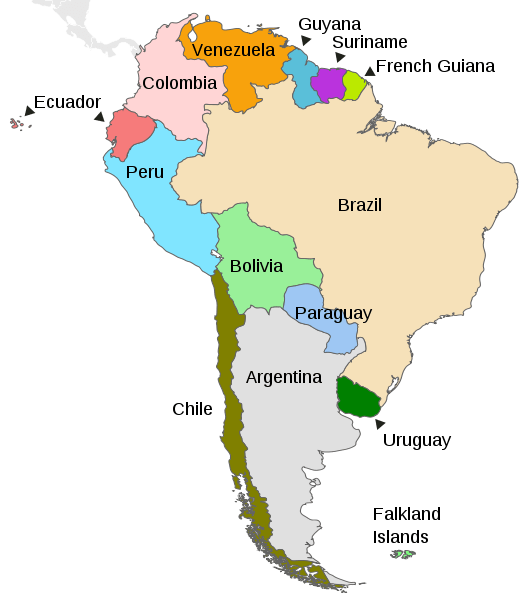
Map depicting the countries on the continent of South America
Natural Geography of Colombia
Natural Regions
Colombia generally classifies its geographic landscape into six natural regions:
- The Caribbean Region: in the north
- The Pacific/Chocó Region: in the west
- The Andean Region: at the center
- The Orinoco Region: in the east
- The Amazon Region: in the south
- The Insular Region: in the Caribbean Sea and the Pacific Ocean
Caribbean Region
The Caribbean Natural Region stretches from the Gulf of Uraga in the west to the Guajira Peninsula in the east. The region also hosts the historic port cities of Cartagena and Santa Marta, the first areas settled by the Europeans.
The Caribbean region is traversed by rivers that flow from the Andean highlands and empty into the Caribbean Sea, including the Magdalena, Colombia's principal waterway. Ecosystems include humid forests, dry forests, savannas, wetlands, the Sierra Nevada de Santa Marta mountain range and the Guajira Desert.
The Caribbean coast has a hot and humid climate year-round. The average temperature is 27 °C (81 °F), and the average humidity is 80%. The wet season runs from May to November, and the dry season runs from December to April.
Pacific/Chocó Region
The Pacific/Chocó Natural Region, also known as the "Colombian Chocó," comprises an area of approximately 75,000 sq km (29,000 sq mi) on the west coast of Colombia. The terrain is mostly flat and covered by dense rainforests, rivers, swamps, and mangroves. The Pacific Ocean borders the region on the west and the Cordillera Occidental of the Colombian Andes to the east. To the south is the border with Peru. To the north is the Darién Gap and the border with Panama.
Ecologically, the region belongs entirely to the Chocó Biogeographic Region and is part of the Tumbes-Chocó-Magdalena hotspot. Due to a combination of evolutionary, ecological, climatic, and geologic factors, this region presents the highest biodiversity concentration per area in the world. Between 7,000 and 8,000 of the 45,000 species registered in Colombia are found in the Chocó. Endemic plant species total more than 2,000, while endemic birds comprise more than 100 species, representing the highest endemism levels on the planet.
The Pacific coast has a warm and humid climate year-round. The average temperature is 26 °C (79 °F), and the average humidity is 85%. The wet season runs from May to November, and the dry season runs from December to April. Some areas experience rainfall rates that are among the highest in the world.
Andean Region
The Andean Natural Region is the most populated natural region of Colombia. Along with its many mountains, it contains most of the country's urban centers. These urban centers were also the location of the most significant pre-Columbian indigenous settlements. The Andean region also hosts a substantial portion of the Magdalena River and basin, the most important in Colombia regarding economic and environmental significance.
North of the Colombian Massif in the extreme southwest, the Colombian Andes divide into three parallel mountain chains:
- Cordillera Occidental: The western range runs adjacent to the Pacific coast and is home to the city of Cali.
- Cordillera Central: The middle range runs up the country's center between the Cauca and Magdalena river valleys.
- Cordillera Oriental: The eastern range extends northeast towards the Guajira Peninsula and includes the cities of Bogotá, Bucaramanga, and Cúcuta.
The Andes Mountains have a cooler climate than the coast, with temperatures varying depending on the altitude. The average temperature in the temperate zone is 18 °C (64 °F), and the average temperature in the cold zone is 13 °C (55 °F). The wet season runs from April to May and October to November, and the dry season runs from December to January and July to August.
Orinoco Region
The Orinoco (or Orinoquía) Natural Region is part of the Llanos, a vast tropical grassland plain situated east of the Andes. The region belongs to the Orinoco River watershed. The sparsely populated area is rich in oil and suitable for extensive ranching. The region's ecosystems are tropical savanna with gallery forests and wetlands along the rivers.
Amazon Region
The Amazon Natural Region is located in southern Colombia and the Amazon Basin. Mostly covered by tropical rainforest, it covers approximately 35% of Colombia's territory. The region is bounded west by the Cordillera Oriental of the Colombian Andes and extends to the Venezuelan and Brazilian borders in the east.
The Amazon Rainforest has a hot and humid climate year-round. The average temperature is 27 °C (81 °F), and the average humidity is 90%. The wet season runs from October to May, and the dry season runs from June to September.
Insular Region
Some consider the Insular Region not a natural but a geopolitical region of Colombia. It comprises the areas outside the continental territories of the country, some of which are sometimes classified with the Caribbean Natural Region instead.
The Insular Region includes the Archipelago of San Andres, Providencia and Santa Catalina in the Caribbean Sea, Malpelo Island, and Gorgona Island in the Pacific Ocean. Its subregions include other groups of islands:
- Archipiélago de San Bernardo (in the Morrosquillo Gulf, Caribbean).
- Islas del Rosario (Caribbean)
- Isla Fuerte (Caribbean)
- Isla Barú (Caribbean)
- Isla Tortuguilla (Caribbean)
- Isla Tierra Bomba (Caribbean)
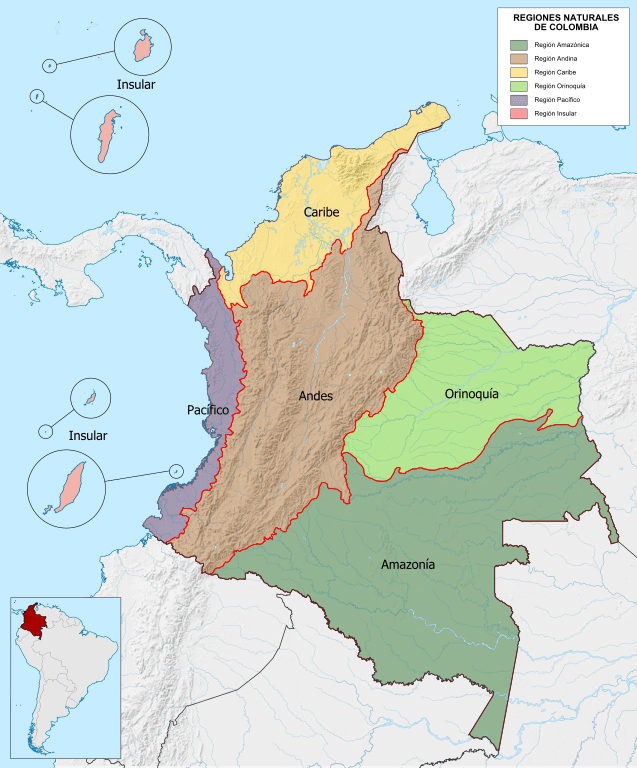
Map depicting the natural regions of Colombia
Mountain Ranges
The mountain ranges of Colombia contribute to the country's diverse landscapes and ecological importance and offer outdoor activities, research, and exploration opportunities. They showcase the remarkable geographical features and natural beauty that make Colombia a unique and fascinating country.
See more: Mountain Ranges of Colombia
Islands and Archipelagos
Colombia has many islands and archipelagos in the Caribbean Sea and the Pacific Ocean. These islands vary in size, culture, and natural beauty. Each destination has its unique charm, from pristine beaches and vibrant marine life to historical sites and cultural experiences.
See more: Islands and Archipelagos of Colombia
Bodies of Water
The bodies of water of Colombia contribute to the country's diverse natural beauty, provide vital resources, and support a variety of ecosystems and human activities. They offer opportunities for tourism, recreation, and exploring Colombia's rich aquatic environments.
See more: Water Bodies of Colombia
Administrative Divisions
Colombia comprises 32 departments and a Capital District. A grouping of municipalities forms departments. Each department has a capital, a Governor, and an Assembly.
See more: Cultural Landscape of Colombia
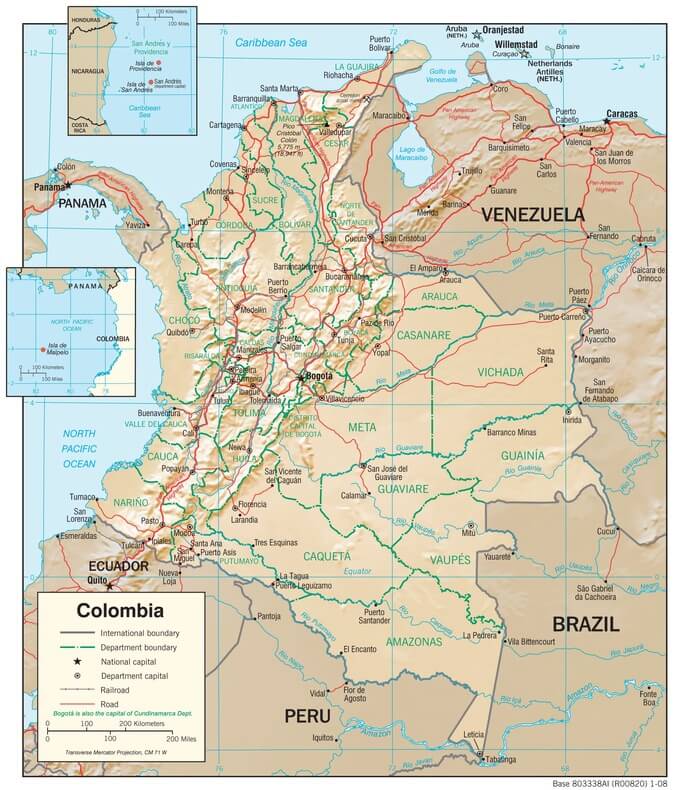
Colombia physiographic map
Biomes
Colombia's complex climate, soil, and topography pattern have produced an extraordinary range of plants and plant communities. They range from the mangrove swamps of the coasts, the desert scrub of La Guajira, the savanna grasslands and gallery ecosystems of the Atlantic lowlands and the Llanos, the rainforests of the Amazon and Chocó natural regions to the widely diverse and complex montane ecosystems of the Andean slopes.
- Moist Forest: tropical and subtropical moist broadleaf forests
- Dry Forest: tropical and subtropical dry broadleaf forests
- Grasslands: tropical and subtropical grasslands, savannas, and shrublands
- Montane Grasslands: montane grasslands and shrublands
- Desert: deserts and Xeric shrublands
- Mangroves: salt-tolerant trees, shrubs, and other vegetation
Ecosystems
- Páramo: tussock grasses and frailejones
- Upper Montane Forest: diverse vegetation at slightly lower elevations
- Lower Montane Forest: mix of evergreen and deciduous trees at lower altitudes
- Dry Forest of the inter-Andean Valleys: drought-resistant vegetation adapted to seasonal water variations
- Savanna of the Llanos Oriental: tropical grassland
- Amazonian Rainforest and other lowlands: lush and biodiverse lowland ecosystems
Ecological Regions
The following is a list of terrestrial ecoregions in Colombia, as defined by the World Wide Fund for Nature (WWF). Colombia is in the Neotropical realm. Ecoregions are classified by biome type - the major global plant communities determined by rainfall and climate.
Tropical and subtropical moist broadleaf forests
- Caquetá moist forests
- Cauca Valley montane forests
- Cayos Miskitos - San Andrés and Providencia moist forests
- Chocó-Darién moist forests
- Cordillera Oriental montane forests
- Eastern Cordillera Real montane forests
- Eastern Panamanian montane forests
- Guayanan Highlands moist forests
- Japurá-Solimões-Negro moist forests
- Magdalena Valley montane forests
- Magdalena-Urabá moist forests
- Napo moist forests
- Negro-Branco moist forests
- Northwestern Andean montane forests
- Purus várzea
- Rio Negro campinarana
- Santa Marta montane forests
- Solimões-Japurá moist forests
- Venezuelan Andes montane forests
- Western Ecuador moist forests
Tropical and subtropical dry broadleaf forests
- Apure-Villavicencio dry forests
- Cauca Valley dry forests
- Patía Valley dry forests
- Sinú Valley dry forests
Tropical and subtropical grasslands, savannas, and shrublands
Montane grasslands and shrublands
Deserts and xeric shrublands
- Guajira-Barranquilla xeric scrub
- Malpelo Island xeric scrub
Mangroves
- Esmeraldas-Pacific Colombia mangroves
- Magdalena-Santa Marta mangroves
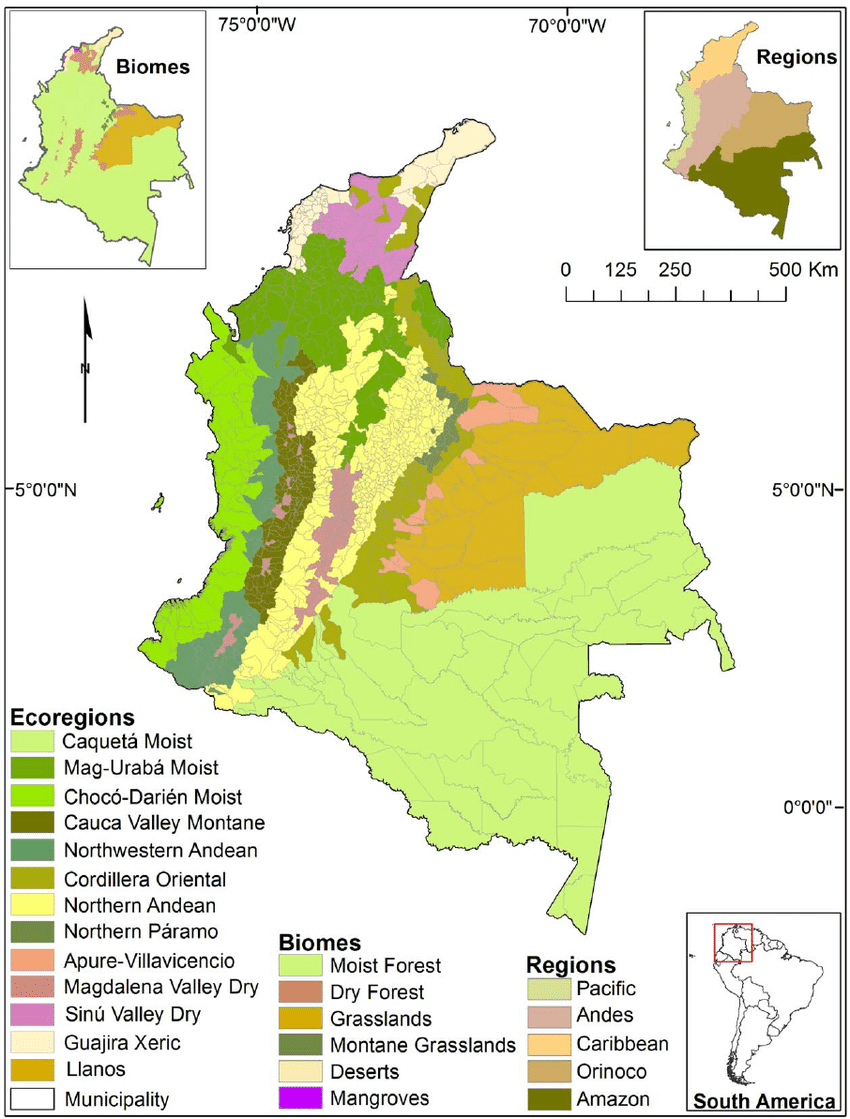
Colombia ecoregions and biomes map
